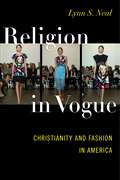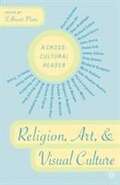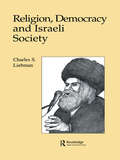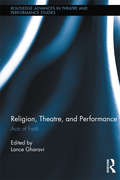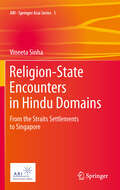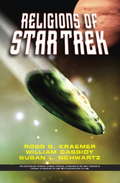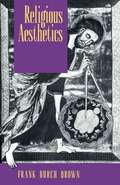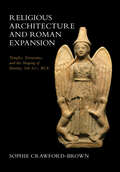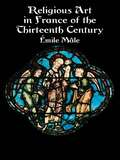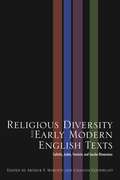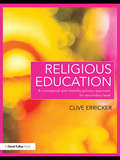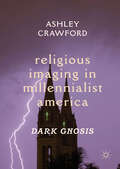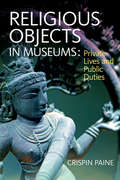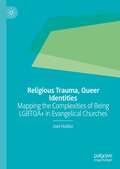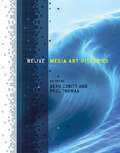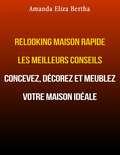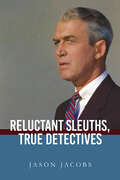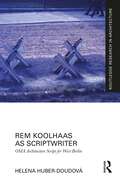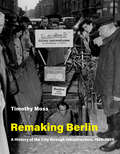- Table View
- List View
Religion in Vogue: Christianity and Fashion in America
by Lynn S. NealHow the fashion industry has contributed to religious change From cross necklaces to fashion designs inspired by nuns’ habits, how have fashion sources interpreted Christianity? And how, in turn, have these interpretations shaped conceptions of religion in the United States? Religion in Vogue explores the intertwined history of Christianity and the fashion industry. Using a diverse range of fashion sources, including designs, jewelry, articles in fashion magazines, and advertisements, Lynn S. Neal demonstrates how in the second half of the twentieth century the modern fashion industry created an aestheticized Christianity, transforming it into a consumer product. The fashion industry socialized consumers to see religion as fashionable and as a beautiful lifestyle accessory—something to be displayed, consumed, and experienced as an expression of personal identity and taste. Religion was something to be embraced and shown off by those who were sophisticated and stylish, and not solely the domain of the politically conservative. Neal ultimately concludes that, through aestheticizing Christianity, the fashion industry has offered Americans a means of blending traditional elements of religion—such as ritual practice, miraculous events, and theological concepts—with modern culture, revealing a new dimension to the personal experience of religion.
Religion, Art, and Visual Culture: A Cross-Cultural Reader
by S. Brent PlateThis book is a cross-cultural exploration of the study of visuality and the arts from a religious perspective. This forward looking and accessible collection gathers together the most current scholarship for those interested in art, religion, visual culture, and cultural studies. <p><p> Inherently interdisciplinary, this reader approaches the study of world religions through the human, meaning-making activity of seeing. The volume oscillates between specific visual subjects (painting, landscape gardens, calligraphy, architecture, mass media) and the broader theoretical discourses which are relevant to Humanities students today.
Religion, Democracy and Israeli Society
by Charles S. LiebmanFirst Published in 1997. The essays in this volume are revisions, in some cases substantial, to the 1995 Sherman Lectures which the author delivered at SOAS, the School of Oriental and African Studies of the University of London.
Religion, Theatre, and Performance: Acts of Faith (Routledge Advances in Theatre & Performance Studies)
by Lance GharaviThe intersections of religion, politics, and performance form the loci of many of the most serious issues facing the world today, sites where some of the world’s most pressing and momentous events are contested and played out. That this circumstance warrants continued, thoughtful, and imaginative engagement from those within the fields of theatre and performance is one of the guiding principles of this volume. This collection features a diverse set of perspectives, written by some of the top scholars in the relevant fields, on the many modern intersections of religion with theatre and performance. Contributors argue that religion can no longer be conceived of as a cultural phenomenon that is safely sequestered in the "private sphere." It is instead an explicitly public force that stimulates and complicates public actions, and thus a crucial component of much performance. From mystic theologies of acting to the neuroscience of spirituality in rituals to the performance of secularism, these essays address a broad variety of religious traditions, sharing a common conception of religion as a crucial object of discourse—one that is formed by, and significantly formative of, performance.
Religion-State Encounters in Hindu Domains
by Vineeta SinhaThe historical and empirical project presented here is grounded in a desire to theorize 'religion-state' relations in the multi-ethnic, multi-religious, secular city-state of Singapore. The core research problematic of this project has emerged out of the confluence of two domains, 'religion, law and bureaucracy' and 'religion and colonial encounters.' This work has two core objectives: one, to articulate the actual points of engagement between institutions of religion and the state, and two, to identify the various processes, mechanisms and strategies through which relations across these spheres are sustained. The thematic foundations of this book rest on disentangling the complex interactions between religious communities, individuals and the various manifestations of the Singapore state, relationships that are framed within a culture of bureaucracy. This is accomplished through a scrutiny of Hindu domains on the island nation-state, from her identity as part of the Straits Settlements to the present day. The empirical and analytical emphases of this book rest on the author's engagement with the realm of Hinduism as it is conceived, structured, framed and practiced within the context of a strong state in Singapore today. Ethnographically,the book focusses on Hindu temple management and the observance of Hindu festivals and processions, enacted within administrative and bureaucratic frames.
Religions Of Star Trek
by Ross Kraemer William Cassidy Susan L SchwartzIs there a God? What evil lurks beyond the stars? Can science save one’s soul? Profound questions like these have consumed human thought over the ages; they also inspired the original creators of the Star Trek canon of TV series and films. Religions of Star Trek tackles these challenging questions head-on in a remarkable look at one of sci-fi’s great success stories. Analyzing more than three decades of screen adventure, the authors depict a Star Trek transformed, corresponding to the resurgence of religion in American public discourse. The authors identify the many religious characters in Star Trek, tracing the roots of scientific humanism to more contemporary aspects of religion and spirituality. Through it all, the creators’ visionary outlook remains constant: a humanistic faith in free will and the salvific nature of dispassionate scientific inquiry. This book was not prepared, licensed, approved, or endorsed by any entity involved in creating or producing the Star Trek television series or films.
Religious Aesthetics: A Theological Study of Making and Meaning
by Frank BrowningMany modes of religious expression and experience have a markedly aesthetic component, even though aesthetic delight itself often appears to be free of moral or religious interests. In this ground-breaking work, Frank Burch Brown shows how aesthetics, no less than ethics, can play a central role in the study of religion and in the practice of theology.
Religious Architecture and Roman Expansion: Temples, Terracottas, and the Shaping of Identity, 3rd-1st c. BCE
by Sophie Crawford-BrownReligious Architecture and Roman Expansion uses architectural terracottas as a lens for examining the changing landscape of central Italy during the period of Roman military expansion, and for asking how local communities reacted to this new political reality. It emphasizes the role of local networks and exchange in the creation of communal identity, as well as the power of visual expression in the formulation and promotion of local history. Through detailed analyses of temple terracottas, Sophie Crawford-Brown sheds new light on 'Romanization' and colonization processes between the 3rd and 1st centuries BCE. She investigates the interactions between colonies and indigenous communities, asking why conquerors might visually emulate the conquered, and what this can mean for power relations in colonial situations. Finally, Crawford-Brown explores the role of objects in creating cultural memory and the intensity of our need for collective history-even when that 'history' has been largely invented.
Religious Art in France of the Thirteenth Century (Dover Fine Art, History Of Art Series)
by Emile MâleThe art in medieval cathedrals, in addition to its profound aesthetic appeal, told unlettered churchgoers a series of morality tales. From divine creation to the lives of the saints, the stone sculpture and stained glass windows provided dramatic illustrations of the key elements of Christian doctrine. Unfortunately, the true meaning of these religious artworks was gradually obscured by time. In 1913, however, this brilliant study appeared, clarifying and illuminating the original ideas and concepts behind the sacred art of the Middle Ages.
Religious Buildings Made in Byzantium: Old Monuments, New Interpretations (New Approaches to Byzantine History and Culture)
by Nikos D. Kontogiannis Ivana Jevtić Nebojša StankovićEach chapter of this volume provides a window into the vibrant world of Middle and Late Byzantium, offering new insights into the complexities of Byzantine ecclesiastical spaces. This illuminating exploration reaches beyond the traditional focus on churches solely as buildings, unveiling the complex tapestry of cultural and social dynamics contained therein. From the towering monuments of Constantinople to hidden gems scattered throughout the empire, the scholars gathered here chart a new course, embracing inclusivity and diachronic perspectives. They trace not only architectural typologies but also material culture, ritual contexts, and sensory experiences, reaching a holistic understanding of the church building. Insights from archaeology, art history, anthropology, and other fields paint a nuanced picture of how Byzantine churches—including the subtleties of sculpted decorations, painted frescoes, and architectural elements—functioned within their communities and historical contexts. Blending regional specificities with global perspectives and sensitivity for the intricate interplay of history, culture, and human agency embodied in these enduring edifices, Religious Buildings Made in Byzantium: Old Monuments – New Interpretations challenges conventional narratives through a set of compelling journeys into the rich legacy of Byzantine religious architecture.
Religious Diversity and Early Modern English Texts: Catholic, Judaic, Feminist, and Secular Dimensions
by Arthur F. Marotti Chanita GoodblattIn Religious Diversity and Early Modern English Texts: Catholic, Judaic, Feminist, and Secular Dimensions, editors Arthur F. Marotti and Chanita Goodblatt present thirteen essays that examine the complex religious culture of early modern England. Emphasizing particularly the marginalized discourses of Catholicism and Judaism in mainstream English Protestant culture, the authors highlight the instability of an official religious order that was troubled not only by religious heterodoxy but also by feminist and secular challenges. North American and Israeli scholars present essays on a wide range of subjects all assumed to be "marginal" but which in a real sense were central to the religious and cultural life of the Protestant English nation. Using critical methods ranging from historical analysis, deconstruction, feminist inquiry, and intertextual interpretation to pedagogical experimentation, contributors offer analyses in five sections: Minority Catholic Culture, Figuring the Jew, Hebraism and the Bible, Women and Religion, and Religion and Secularization. Essays reveal new aspects of familiar texts such as Shakespeare's King Lear and The Merchant of Venice, the psalm translations by Sir Philip Sidney and the Countess of Pembroke, Christopher Marlowe's dramas, George Herbert's poetry, Aemelia Lanyer's Salve Deus Rex Judaeorum, and John Milton's Samson Agonistes. They also call attention to works such as the mid-sixteenth-century play The Historie of Jacob and Esau, William Blundell's Catholic antiquarian writing, the series of paintings portraying the religious institute of Mary Ward, and funeral sermons for religiously active women. Contributors show that we cannot understand a culture without attending to its repressed, marginalized, and unacknowledged elements. Scholars of religious, literary, and cultural history will enjoy this illuminating collection.
Religious Education: A Conceptual and Interdisciplinary Approach for Secondary Level
by Clive ErrickerThe role of Religious Education in secondary schools is the subject of national and international debate. This book examines the current debates surrounding RE and puts forward a new approach to teaching the subject that is non-faith based and focused on conceptual enquiry and the development of a clear pedagogy. The book is based on the Living Difference learning model developed in Hampshire and adopted in other parts of the UK, which is sparking international discussion and provides an effective approach to implementing the new secondary curriculum. The chapters include examinations of: religious education and the curriculum an interdisciplinary approach to religious education the significance of pedagogy and learners’ development planning, progression, assessment and delivery specific case studies and examples of good practice in schools theoretical grounding and the future of RE the effects of globalisation, post-modernity and multiculturalism. Providing a basis for developing thinking about Religious Education, its place in the curriculum and how it can be delivered effectively in schools, this book is essential reading for tutors, students and teachers.
Religious Imaging in Millennialist America: Dark Gnosis
by Ashley CrawfordAshley Crawford investigates how such figures as Ben Marcus, Matthew Barney, and David Lynch—among other artists, novelists, and film directors—utilize religious themes and images via Christianity, Judaism, and Mormonism to form essentially mutated variations of mainstream belief systems. He seeks to determine what drives contemporary artists to deliver implicitly religious imagery within a ‘secular’ context. Particularly, how religious heritage and language, and the mutations within those, have impacted American culture to partake in an aesthetic of apocalyptism that underwrites it.
Religious Objects in Museums: Private Lives and Public Duties
by Crispin PaineIn the past, museums often changed the meaning of icons or statues of deities from sacred to aesthetic, or used them to declare the superiority of Western society, or simply as cultural and historical evidence. The last generation has seen faith groups demanding to control 'their' objects, and curators recognising that objects can only be understood within their original religious context. In recent years there has been an explosion of interest in the role religion plays in museums, with major exhibitions highlighting the religious as well as the historical nature of objects.Using examples from all over the world, Religious Objects in Museums is the first book to examine how religious objects are transformed when they enter the museum, and how they affect curators and visitors. It examines the full range of meanings that religious objects may bear - as scientific specimen, sacred icon, work of art, or historical record. Showing how objects may be used to argue a point, tell a story or promote a cause, may be worshipped, ignored, or seen as dangerous or unlucky, this highly accessible book is an essential introduction to the subject.
Religious Representation in Place: Exploring Meaningful Spaces at the Intersection of the Humanities and Sciences (Religion and Spatial Studies)
by Mark K. George Daria Pezzoli-OlgiatiReligious Representation in Place brings together an interdisciplinary group of scholars from the Humanities and Sciences to broaden the understanding of how religious symbols and spatial studies interact. The essays consider the relevance of religion in the experience of space, a fundamental dimension of culture and human life.
Religious Trauma, Queer Identities: Mapping the Complexities of Being LGBTQA+ in Evangelical Churches
by Joel HollierIn a polarised milieu that too often posits “queer” and “Christian” as competing realms, this book explores the complexities of identity development, religious traumatisation, and the task of creating safe faith spaces in which LGBTQA+ people can find healing, particularly in the Evangelical context. First, Joel Hollier examines the historical path of Evangelicalism, providing context for the current terrain of the “culture war” we find ourselves in. He then parses out experiences of gender/sexuality and religious/spiritual identity development, grounding them in an evolving theoretical base. Finally, Hollier offers a rounded critique of Evangelical church structures and mechanisms of trauma that hinder the healing process, along with potential sources of healing. Central to this work are the voices of LGBTQA+ people whose stories weave together a deeper understanding of the harms the Church has perpetrated, and the path forward.
Relive: Media Art Histories
by Paul Thomas Sean CubittIn "Relive," leading historians of the media arts grapple with this dilemma: how can we speak of "new media" and at the same time write the histories of these arts? These scholars and practitioners redefine the nature of the field, focusing on the materials of history -- the materials through which the past is mediated. Drawing on the tools of media archaeology and the history and philosophy of media, they propose a new materialist media art history. The contributors consider the idea of history and the artwork's moment in time; the intersection of geography and history in regional practice, illustrated by examples from eastern Europe, Australia, and New Zealand; the contradictory scales of evolution, life cycles, and bodily rhythms in bio art; and the history of the future -- how the future has been imagined, planned for, and established as a vector throughout the history of new media arts. These essays, written from widely diverse critical perspectives, capture a dynamic field at a moment of productive ferment. ContributorsSusan Ballard, Brogan Bunt, Andr's Burbano, Jon Cates, John Conomos, Martin Constable, Sean Cubitt, Francesca Franco, Darko Fritz, Zhang Ga, Monika Gorska-Olesinska, Ross Harley, Jens Hauser, Stephen Jones, Douglas Kahn, Ryszard W. Kluszczynski, Caroline Seck Langill, Leon Marvell, Rudy Rucker, Edward A. Shanken, Stelarc, Adele Tan, Paul Thomas, Darren Tofts, Joanna Walewska
Relive: Media Art Histories (Leonardo)
by Paul Thomas Sean CubittLeading historians of the media arts define a new materialist media art history, discussing temporality, geography, ephemerality, and the future.In Relive, leading historians of the media arts grapple with this dilemma: how can we speak of “new media” and at the same time write the histories of these arts? These scholars and practitioners redefine the nature of the field, focusing on the materials of history—the materials through which the past is mediated. Drawing on the tools of media archaeology and the history and philosophy of media, they propose a new materialist media art history. The contributors consider the idea of history and the artwork's moment in time; the intersection of geography and history in regional practice, illustrated by examples from eastern Europe, Australia, and New Zealand; the contradictory scales of evolution, life cycles, and bodily rhythms in bio art; and the history of the future—how the future has been imagined, planned for, and established as a vector throughout the history of new media arts. These essays, written from widely diverse critical perspectives, capture a dynamic field at a moment of productive ferment.ContributorsSusan Ballard, Brogan Bunt, Andrés Burbano, Jon Cates, John Conomos, Martin Constable, Sean Cubitt, Francesca Franco, Darko Fritz, Zhang Ga, Monika Gorska-Olesinska, Ross Harley, Jens Hauser, Stephen Jones, Douglas Kahn, Ryszard W. Kluszczynski, Caroline Seck Langill, Leon Marvell, Rudy Rucker, Edward A. Shanken, Stelarc, Adele Tan, Paul Thomas, Darren Tofts, Joanna Walewska
Relocating Television: Television in the Digital Context (Comedia)
by Gripsrud JosteinFor over half a century, television has been the most central medium in Western democracies – the political, social and cultural centrepiece of the public sphere. Television has therefore rarely been studied in isolation from its socio-cultural and political context; there is always something important at stake when the forms and functions of television are on the agenda. The digitisation of television concerns the production, contents, distribution and reception of the medium, but also its position in the overall, largely digitised media system and public sphere where the internet plays a decisive role. The articles in this comprehensive collection are written by some of the world’s most prominent scholars in the field of media, communication and cultural studies, including critical film and television studies. Relocating Television offers readers an insight into studying television alongside the internet, participatory media and other technocultural phenomena such as DVDs, user-generated content and everyday digital media production. It also focuses on more specific programmes and phenomena, including The Wire, MSN, amateur footage in TV news, Bollywoodization of TV news, YouTube, fan sites tied to e.g. Grey's Anatomy and X Factor. Relocating Television will be highly beneficial to both students and academics across a wide range of undergraduate and postgraduate courses including media, communication and cultural studies, and television and film studies.
Relocating the Law of Geographical Indications
by Dev GangjeeThere is huge variation in the nature, scope and institutional forms of legal protection for valuable geographical brands such as Champagne, Colombian coffee and Darjeeling tea. Although regional products are becoming more significant to producers, consumers and policy makers, the international legal regime under the TRIPs Agreement remains unclear. Adopting a historical approach, Dev Gangjee explores the rules regulating these brands within international intellectual property law. He traces the emergence of geographical indications as a distinct category and investigates the link between regional products and their places of origin. The research addresses longstanding puzzles, such as the multiplicity of regimes operating in this area; the recognition of the link between product and place and its current articulation in the TRIPs definition; the varying scope of protection; and the extent to which geographical indications ought to be treated as a category distinct from trade marks.
Relooking Maison Rapide les Meilleurs Conseils: Concevez, décorez et meublez votre maison idéale.
by Amanda Eliza Bertha Anna CollinsQuand vous rêvez, laissez votre esprit s'envoler. Ne laissez pas les questions telles que l'argent et l'emplacement empêcher le développement de vos plans idéales pour votre maison parfaite. Il n'y a aucune raison de laisser la réalité gâcher vos rêves. En laissant vos rêves se développer sans entraves, vous serez en mesure de créer le meilleur résultat possible pour vos conditions de vie. En d'autres mots, voyez grand. Ce livre va vous guider à travers les étapes de la conception, la décoration et l'ameublement de votre maison idéale.
Reluctant Sleuths, True Detectives (SUNY series, Horizons of Cinema)
by Jason JacobsReluctant Sleuths, True Detectives examines the detective figure in four noir and neo-noir films: Out of the Past (1947), Notorious (1946), Vertigo (1958), and Chinatown (1974). Exploring the way that these characters each move from an initial state of reluctant passivity to one of passionate engagement with the world around them, it questions the cinematic forces required to motivate and move them. In its close examinations of each film, the book meditates on the detectives' hunts and how they interact with the cinematic apparatus that captures and presents them to an audience, and it tracks the receptive experience of these films in relation to these questions of motivation and movement.
Rem Koolhaas as Scriptwriter: OMA Architecture Script for West Berlin (Routledge Research in Architecture)
by Helena Huber-DoudováThis book is the first survey of a new field in architecture theory: script writing. Rem Koolhaas as Scriptwriter explores the intersection of architecture, film, and text using the example of the working method of scriptwriter, Rem Koolhaas, and the Office for Metropolitan Architecture (OMA). This book argues that Koolhaas formulates his approach to architecture on the basis of the “written sketch” or script, and questions its transformations into built environment in the oeuvre of OMA. Divided into two parts, the first part is a theoretical outline that explores the notion of scriptwriting in film. It provides in-depth insights into the definition and historical evolution of the script—as a blueprint, Hollywood script, avant-garde script, storyboard, the relation to auteur theory, and the difference between the script and scenario. It surveys the first original script for the Exodus, of the Voluntary Prisoners of Architecture. The second part offers a unique perspective on the urban development of West Berlin, in which Koolhaas created a metropolitan script, or blueprint, that spans the period 1971–1989, from his first visit to Berlin to the fall of the Berlin Wall. This book will be of interest to researchers and students of architectural theory, urban history, and film studies.
Remaking Berlin: A History of the City through Infrastructure, 1920-2020 (Infrastructures)
by Timothy MossAn examination of Berlin's turbulent history through the lens of its water and energy infrastructures.In Remaking Berlin, Timothy Moss takes a novel perspective on Berlin's turbulent twentieth-century history, examining it through the lens of its water and energy infrastructures. He shows that, through a century of changing regimes, geopolitical interventions, and socioeconomic volatility, Berlin's networked urban infrastructures have acted as medium and manifestation of municipal, national, and international politics and policies. Moss traces the coevolution of Berlin and its infrastructure systems from the creation of Greater Berlin in 1920 to remunicipalization of services in 2020, encompassing democratic, fascist, and socialist regimes.
Remaking Birmingham: The Visual Culture of Urban Regeneration
by Liam KennedyThe city of Birmingham offers a particularly rich case study on urban regeneration as it strives to build a new city image. Positioned between decline and regeneration, the landscape of the city and its environs collages old and new, producing dramatic contrasts - of industrial and post-industrial urbanisms of crumbling brutalism and spectacular flagship developments, of Victorian housing and diverse cultural lifestyles - that compound the aesthetic and socio-economic means of regeneration. This visually exciting book also reflects upon and extends current debates about public space, cultural zoning and the futures of cities.
